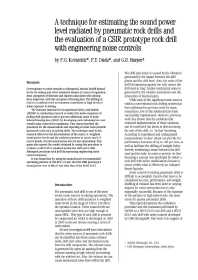Mining Publication: A Technique for Estimating the Sound Power Level Radiated by Pneumatic Rock Drills and the Evaluation of a CSIR Prototype Rock Drill with Engineering Noise Controls
Original creation date: May 2009
Overexposure to noise remains a widespread, serious health hazard in the US mining and other industries despite 25 years of regulation. Most categories of illnesses and injuries associated with mining have improved, with the exception of hearing loss. The drilling of rock in a confined work environment contributes to high levels of noise exposure in mining. The National Institute for Occupational Safety and Health (NIOSH) is conducting research to reduce the noise exposures of jackleg drill operators and to prevent additional cases of noise induced hearing loss (NIHL) by developing and evaluating low-cost retrofit noise controls for equipment. This report describes the procedure for the measurement and reporting of noise from portable pneumatic tools such as jackleg drills. The technique used in this research allows for the determination of the source A-weighted sound power levels and the radiation patterns in octave and 1/3 octave bands. Overall sound power level is also determined. This paper also reports the results obtained by using this procedure to evaluate a SECO S215 standard production drill and a CSIR Miningtek prototype rock drill incorporating engineering noise control measures. It was found that by using the manufacture's recommended operating pressure of 496 kPa (72 psi) that the CSIR prototype's sound power was 10 dB (A) less then that of the SECO S215.
Authors: PG Kovalchik, FT Duda, GS Harper
Peer Reviewed Journal Article - May 2009
NIOSHTIC2 Number: 20035761
J S Afr Inst Min Metall 2009 May; 109(5):295-299
See Also
- Acoustic Assessment of Pneumatic and Electric Jackleg Drills used in the Mining Industry
- Analysis of a Mechanism Suspension to Reduce Noise from Horizontal Vibrating Screens
- Cross-Sectional Survey of Noise Exposure in the Mining Industry
- Determining Underground Roof Bolting Machine Operators Noise Exposure Using Laboratory Results
- Limestone Mining: Is It Noisy or Not?
- A Noise Control for A Roof Bolting Machine: Collapsible Drill Steel Enclosure
- Noise Exposure in Longwall Mining and Engineering Controls Research
- Sound Power Level Study of a Roof Bolter
- Underground Evaluation of Coated Flight Bars for a Continuous Mining Machine
- Water Well Safety Bits: Health And Safety Information For The Water Well Industry
- Content source: National Institute for Occupational Safety and Health, Mining Program


 ShareCompartir
ShareCompartir
